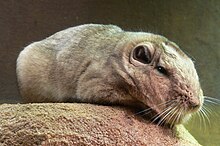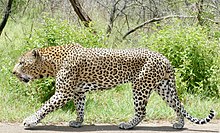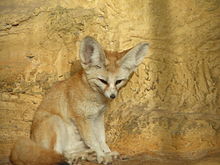bio.wikisort.org - Animal
This list of the mammal species recorded in Algeria provides information about the status of the 120 mammal species occurring in Algeria. Three are critically endangered, two are endangered, ten are vulnerable, and three are near threatened.
The following tags are used to highlight each species' conservation status as assessed on the IUCN Red List:
| EX | Extinct | No reasonable doubt that the last individual has died. |
| EW | Extinct in the wild | Known only to survive in captivity or as a naturalized populations well outside its previous range. |
| CR | Critically endangered | The species is in imminent risk of extinction in the wild. |
| EN | Endangered | The species is facing an extremely high risk of extinction in the wild. |
| VU | Vulnerable | The species is facing a high risk of extinction in the wild. |
| NT | Near threatened | The species does not meet any of the criteria that would categorise it as risking extinction but it is likely to do so in the future. |
| LC | Least concern | There are no current identifiable risks to the species. |
| DD | Data deficient | There is inadequate information to make an assessment of the risks to this species. |
Order: Macroscelidea (elephant shrews)
Often called sengis, the elephant shrews or jumping shrews are native to southern Africa. Their common English name derives from their elongated flexible snout and their resemblance to the true shrews.
- Family: Macroscelididae (elephant shrews)
- Genus: Petrosaltator
- North African elephant shrew, P. rozeti LC
- Genus: Petrosaltator
Order: Hyracoidea (hyraxes)
The hyraxes are any of four species of fairly small, thickset, herbivorous mammals in the order Hyracoidea. About the size of a domestic cat they are well-furred, with rounded bodies and a stumpy tail. They are native to Africa and the Middle East.
- Family: Procaviidae (hyraxes)
- Genus: Procavia
- Cape hyrax, P. capensis LC
- Genus: Procavia
Order: Primates

The order Primates contains humans and their closest relatives: lemurs, lorisoids, tarsiers, monkeys, and apes.
- Suborder: Haplorhini
- Infraorder: Simiiformes
- Parvorder: Catarrhini
- Superfamily: Cercopithecoidea
- Family: Cercopithecidae (Old World monkeys)
- Genus: Macaca
- Barbary macaque, M. sylvanus EN
- Genus: Macaca
- Family: Cercopithecidae (Old World monkeys)
- Superfamily: Cercopithecoidea
- Parvorder: Catarrhini
- Infraorder: Simiiformes
Order: Rodentia (rodents)



Rodents make up the largest order of mammals, with over 40 percent of mammalian species. They have two incisors in the upper and lower jaw which grow continually and must be kept short by gnawing. Most rodents are small though the capybara can weigh up to 45 kg (100 lb).
- Suborder: Hystricomorpha
- Family: Hystricidae (Old World porcupines)
- Genus: Hystrix
- Crested porcupine, Hystrix cristata LC[1]
- Genus: Hystrix
- Family: Ctenodactylidae
- Genus: Ctenodactylus
- Common gundi, Ctenodactylus gundi LC
- Val's gundi, Ctenodactylus vali DD
- Genus: Massoutiera
- Mzab gundi, Massoutiera mzabi LC
- Genus: Ctenodactylus
- Family: Hystricidae (Old World porcupines)
- Suborder: Sciurognathi
- Family: Sciuridae (squirrels)
- Subfamily: Xerinae
- Genus: Atlantoxerus
- Barbary ground squirrel, Atlantoxerus getulus LC
- Genus: Atlantoxerus
- Subfamily: Xerinae
- Family: Gliridae (dormice)
- Subfamily: Leithiinae
- Genus: Eliomys
- Asian garden dormouse, Eliomys melanurus LC[2]
- Maghreb garden dormouse, Eliomys munbyanus LC
- Genus: Eliomys
- Subfamily: Leithiinae
- Family: Dipodidae (jerboas)
- Subfamily: Dipodinae
- Genus: Jaculus
- Lesser Egyptian jerboa, Jaculus jaculus LC
- Greater Egyptian jerboa, Jaculus orientalis LC
- Genus: Jaculus
- Subfamily: Dipodinae
- Family: Muridae (mice, rats, voles, gerbils, hamsters, etc.)
- Subfamily: Deomyinae
- Genus: Acomys
- Seurat's spiny mouse, Acomys seurati LC
- Genus: Acomys
- Subfamily: Gerbillinae
- Genus: Dipodillus
- North African gerbil, Dipodillus campestris LC
- Genus: Gerbillus
- Lesser Egyptian gerbil, Gerbillus gerbillus LC
- Pygmy gerbil, Gerbillus henleyi LC
- Balochistan gerbil, Gerbillus nanus LC
- Lesser short-tailed gerbil, Gerbillus simoni LC
- Tarabul's gerbil, Gerbillus tarabuli LC
- Genus: Meriones
- Sundevall's jird, Meriones crassus LC
- Libyan jird, Meriones libycus LC
- Shaw's jird, Meriones shawi LC
- Genus: Pachyuromys
- Fat-tailed gerbil, Pachyuromys duprasi LC
- Genus: Psammomys
- Fat sand rat, Psammomys obesus LC
- Thin sand rat, Psammomys vexillaris DD
- Genus: Dipodillus
- Subfamily: Murinae
- Genus: Apodemus
- Wood mouse, Apodemus sylvaticus LC
- Genus: Lemniscomys
- Barbary striped grass mouse, Lemniscomys barbarus LC
- Genus: Mus
- Algerian mouse, Mus spretus LC
- Genus: Apodemus
- Subfamily: Deomyinae
- Family: Sciuridae (squirrels)
Order: Lagomorpha (lagomorphs)
The lagomorphs comprise two families, Leporidae (hares and rabbits), and Ochotonidae (pikas). Though they can resemble rodents, and were classified as a superfamily in that order until the early 20th century, they have since been considered a separate order. They differ from rodents in a number of physical characteristics, such as having four incisors in the upper jaw rather than two.
- Family: Leporidae (rabbits, hares)
Order: Erinaceomorpha (hedgehogs and gymnures)
The order Erinaceomorpha contains a single family, Erinaceidae, which comprise the hedgehogs and gymnures. The hedgehogs are easily recognised by their spines while gymnures look more like large rats.
- Family: Erinaceidae (hedgehogs)
- Subfamily: Erinaceinae
- Genus: Atelerix
- North African hedgehog, Atelerix algirus LC
- Genus: Hemiechinus
- Desert hedgehog, Hemiechinus aethiopicus LC
- Genus: Atelerix
- Subfamily: Erinaceinae
Order: Soricomorpha (shrews, moles, and solenodons)
The "shrew-forms" are insectivorous mammals. The shrews and solenodons closely resemble mice while the moles are stout-bodied burrowers.
- Family: Soricidae (shrews)
- Subfamily: Crocidurinae
- Genus: Crocidura
- Mauritanian shrew, Crocidura lusitania LC
- Greater white-toothed shrew, Crocidura russula LC
- Whitaker's shrew, Crocidura whitakeri LC
- Genus: Suncus
- Etruscan shrew, Suncus etruscus LC
- Genus: Crocidura
- Subfamily: Crocidurinae
Order: Chiroptera (bats)


The bats' most distinguishing feature is that their forelimbs are developed as wings, making them the only mammals capable of flight. Bat species account for about 20% of all mammals.
- Family: Vespertilionidae
- Subfamily: Myotinae
- Genus: Myotis
- Long-fingered bat, Myotis capaccinii VU[6]
- Geoffroy's bat, Myotis emarginatus LC
- Felten's myotis, Myotis punicus DD
- Genus: Myotis
- Subfamily: Vespertilioninae
- Genus: Eptesicus
- Serotine bat, Eptesicus serotinus LC
- Genus: Hypsugo
- Savi's pipistrelle, Hypsugo savii LC[7]
- Genus: Nyctalus
- Genus: Otonycteris
- Desert long-eared bat, Otonycteris hemprichii LC
- Genus: Pipistrellus
- Egyptian pipistrelle, Pipistrellus deserti LC
- Kuhl's pipistrelle, Pipistrellus kuhlii LC
- Common pipistrelle, Pipistrellus pipistrellus LC
- Rüppell's pipistrelle, Pipistrellus rueppelli LC
- Genus: Eptesicus
- Subfamily: Miniopterinae
- Genus: Miniopterus
- Common bent-wing bat, M. schreibersii NT[10]
- Genus: Miniopterus
- Subfamily: Myotinae
- Family: Rhinopomatidae
- Genus: Rhinopoma
- Egyptian mouse-tailed bat, R. cystops LC[11]
- Lesser mouse-tailed bat, Rhinopoma hardwickei LC
- Greater mouse-tailed bat, Rhinopoma microphyllum LC
- Genus: Rhinopoma
- Family: Molossidae
- Genus: Tadarida
- Egyptian free-tailed bat, Tadarida aegyptiaca LC
- European free-tailed bat, Tadarida teniotis LC
- Genus: Tadarida
- Family: Emballonuridae
- Genus: Taphozous
- Naked-rumped tomb bat, Taphozous nudiventris LC
- Genus: Taphozous
- Family: Rhinolophidae
- Subfamily: Rhinolophinae
- Genus: Asellia
- Trident leaf-nosed bat, A. tridens LC[12]
- Genus: Rhinolophus
- Blasius's horseshoe bat, R. blasii LC[13]
- Geoffroy's horseshoe bat, Rhinolophus clivosus LC
- Mediterranean horseshoe bat, Rhinolophus euryale VU
- Greater horseshoe bat, Rhinolophus ferrumequinum NT
- Lesser horseshoe bat, Rhinolophus hipposideros NT
- Mehely's horseshoe bat, Rhinolophus mehelyi VU
- Genus: Asellia
- Subfamily: Rhinolophinae
Order: Cetacea (whales)

The order Cetacea includes whales, dolphins and porpoises. They are the mammals most fully adapted to aquatic life with a spindle-shaped nearly hairless body, protected by a thick layer of blubber, and forelimbs and tail modified to provide propulsion underwater.
- Suborder: Mysticeti
- Family: Balaenidae (right whales)
- Genus: Eubalaena
- North Atlantic right whale, E. glacialis CR vagrant[14]
- Genus: Eubalaena
- Family: Balaenopteridae (rorqual)
- Subfamily: Megapterinae
- Genus: Megaptera
- Humpback whale, M. novaeangliae LC
- Genus: Balaenoptera
- Common minke whale, Balaenoptera acutorostrata LC
- Fin whale, Balaenoptera physalus VU
- Genus: Megaptera
- Family: Balaenidae (right whales)
- Suborder: Odontoceti
- Superfamily: Platanistoidea
- Family: Delphinidae (marine dolphins)
- Genus: Steno
- Rough-toothed dolphin, S. bredanensis LC
- Genus: Delphinus
- Short-beaked common dolphin, D. delphis LC
- Genus: Orcinus
- Orca, Orcinus orca DD[15]
- Genus: Pseudorca
- False killer whale, Pseudorca crassidens DD
- Genus: Globicephala
- Long-finned pilot whale, Globicephala melas DD
- Genus: Grampus
- Risso's dolphin, Grampus griseus DD
- Genus: Stenella
- Striped dolphin, Stenella coeruleoalba DD
- Genus Tursiops
- Common bottlenose dolphin, Tursiops truncatus VU
- Genus: Steno
- Family Physeteridae (sperm whales)
- Genus: Physeter
- Sperm whale, Physeter macrocephalus VU
- Genus: Physeter
- Family: Delphinidae (marine dolphins)
- Superfamily Ziphioidea (beaked whales)
- Family Ziphidae
- Genus: Ziphius
- Cuvier's beaked whale, Ziphius cavirostris LC
- Genus: Ziphius
- Family Ziphidae
- Superfamily: Platanistoidea
Order: Carnivora (carnivorans)



There are over 260 species of carnivorans, the majority of which eat meat. They have a characteristic skull shape and dentition.
- Suborder: Feliformia
- Family: Felidae (cats)
- Subfamily: Felinae
- Subfamily: Pantherinae
- Genus: Panthera
- Leopard, P. pardus VU[21]
- African leopard, P. p. pardus LC
- Leopard, P. pardus VU[21]
- Genus: Panthera
- Family: Viverridae
- Subfamily: Viverrinae
- Genus: Genetta
- Common genet, G. genetta LC[22]
- Genus: Genetta
- Subfamily: Viverrinae
- Family: Herpestidae (mongooses)
- Genus: Herpestes
- Egyptian mongoose, H. ichneumon LC[23]
- Genus: Herpestes
- Family: Hyaenidae (hyaenas)
- Family: Felidae (cats)
- Suborder: Caniformia
- Family: Canidae (dogs, foxes)
- Family: Mustelidae (mustelids)
- Family: Phocidae (earless seals)
- Genus: Monachus
- Mediterranean monk seal, M. monachus EN presence uncertain[35]
- Genus: Monachus
Order: Artiodactyla (even-toed ungulates)

The even-toed ungulates are ungulates whose weight is borne about equally by the third and fourth toes, rather than mostly or entirely by the third as in perissodactyls. There are about 220 artiodactyl species, including many that are of great economic importance to humans.
- Family: Suidae (pigs)
- Subfamily: Suinae
- Genus: Sus
- Wild boar, S. scrofa LC
- Genus: Sus
- Subfamily: Suinae
- Family: Cervidae (deer)
- Subfamily: Cervinae
- Genus: Cervus
- Red deer, C. elaphus LC
- Barbary stag, C. e. barbarus
- Red deer, C. elaphus LC
- Genus: Dama
- Fallow deer, D. dama LC introduced[36]
- Genus: Cervus
- Subfamily: Cervinae
- Family: Bovidae (cattle, antelope, sheep, goats)
Extinct
The following species are locally extinct in the country:
- Addax, Addax nasomaculatus[40]
- Hartebeest, Alcelaphus buselaphus
- Aurochs, Bos primigenius[41]
- North African elephant, Loxodonta africana pharaohensis[42]
- Red gazelle, Eudorcas rufina
- Hippopotamus, Hippopotamus amphibius[43]
- Scimitar oryx, Oryx dammah
- Lion, Panthera leo[44]
- Brown bear, Ursus arctos[45]
See also
- List of chordate orders
- Lists of mammals by region
- Mammal classification
References
- Amori, G.; Hutterer, R.; Kryštufek, B.; Yigit, N.; Mitsain, G. & Palomo, L. J. (2016). "Hystrix cristata". IUCN Red List of Threatened Species. 2016: e.T10751A115099509.
- Amori, G.; Aulagnier, S.; Hutterer, R.; Kryštufek, B.; Yigit, N.; Mitsain, G. & Palomo, L.J. (2016). "Eliomys melanurus". IUCN Red List of Threatened Species. 2016: e.T7619A115085446.
- Villafuerte, R.; Delibes-Mateos, M. (2019). "Oryctolagus cuniculus". IUCN Red List of Threatened Species. 2019: e.T41291A45189779.
- Johnston, C.H.; Robinson, T.J.; Child, M.F. & Relton, C. (2019). "Lepus capensis". IUCN Red List of Threatened Species. 2019: e.T41277A45186750.
- Johnston, C.H.; Robinson, T.J.; Relton, C.; Child, M.F. & Smith, A.T. (2019). "Lepus victoriae". IUCN Red List of Threatened Species. 2019: e.T41879A45194215.
- Hutson, A. M.; Spitzenberger, F.; Aulagnier, S.; Juste, J.; Karatas, A.; Palmeirim, J. & Paunovic, M. (2010). "Myotis capaccinii". IUCN Red List of Threatened Species. 2010: e.T14126A4399043.
- Hutson, A. M.; Spitzenberger, F.; Juste, J.; Aulagnier, S.; Palmeirim, J.; Paunovic, M. & Karatas, A. (2010). "Hypsugo savii". IUCN Red List of Threatened Species. 2010: e.T44856A10955205.
- Hutson, A. M.; Alcaldé, J. T.; Juste, J.; Karataş, A.; Palmeirim, J. & Paunović, M. (2010). "Nyctalus lasiopterus". IUCN Red List of Threatened Species. 2010: e.T14918A4471682.
- Juste, J. & Paunović, M. (2016). "Nyctalus leisleri". IUCN Red List of Threatened Species. 2016: e.T14919A22016159.
- Gazaryan, S.; Bücs, S. & Çoraman, E. (2021) [errata version of 2020 assessment]. "Miniopterus schreibersii". IUCN Red List of Threatened Species. 2020: e.T81633057A19585652.
- Benda, P. (2017). "Rhinopoma cystops". IUCN Red List of Threatened Species. 2017: e.T82345555A82345569.
- Monadjem, A.; Bergmans, W.; Mickleburgh, S.; Kock, D.; Amr, Z.S.S. & Hutson, A.M. (2017). "Asellia tridens". IUCN Red List of Threatened Species. 2017: e.T80221529A21975715.
- Taylor, P. (2016). "Rhinolophus blasii". IUCN Red List of Threatened Species. 2016: e.T19515A21972073.
- COSEWIC Assessment and Status Report on the North Atlantic Right Whale Eubalaena glacialis in Canada - 2013- Wildlife Species Description and Significance (See Figure 2)
- Reeves, R.; Pitman, R.L. & Ford, J.K.B. (2017). "Orcinus orca". IUCN Red List of Threatened Species. 2017: e.T15421A50368125.
- Belbachir, F. (2008). "Acinonyx jubatus ssp. hecki". IUCN Red List of Threatened Species. 2008: e.T221A13035738.
- Avgan, B.; Henschel, P. & Ghoddousi, A. (2016). "Caracal caracal". IUCN Red List of Threatened Species. 2016: e.T3847A102424310.
- Ghoddousi, A.; Belbachir, F.; Durant, S.M.; Herbst, M. & Rosen, T. (2022). "Felis lybica". IUCN Red List of Threatened Species. 2022: e.T131299383A154907281. doi:10.2305/IUCN.UK.2022-1.RLTS.T131299383A154907281.en.
- Sliwa, A.; Ghadirian, T.; Appel, A.; Banfield, L.; Sher Shah, M. & Wacher, T. (2016). "Felis margarita". IUCN Red List of Threatened Species. 2016: e.T8541A50651884.
- Thiel, C. (2015). "Leptailurus serval". IUCN Red List of Threatened Species. 2015: e.T11638A50654625.
- Stein, A. B.; Athreya, V.; Gerngross, P.; Balme, G.; Henschel, P.; Karanth, U.; Miquelle, D.; Rostro, S.; Kamler, J.F. & Laguardia, A. (2016). "Panthera pardus". IUCN Red List of Threatened Species. 2016: e.T15954A160698029.
- Gaubert, P.; Carvalho, F.; Camps, D. & Do Linh San, E. (2015). "Genetta genetta". IUCN Red List of Threatened Species. 2015: e.T41698A45218636.
- Do Linh San, E.; Maddock, A.H.; Gaubert, P. & Palomares, F. (2016). "Herpestes ichneumon". IUCN Red List of Threatened Species. 2016: e.T41613A45207211.
- Bohm, T. & Höner, O.R. (2015). "Crocuta crocuta". IUCN Red List of Threatened Species. 2015: e.T5674A45194782.
- AbiSaid, M. & Dloniak, S.M.D. (2015). "Hyaena hyaena". IUCN Red List of Threatened Species. 2015: e.T10274A45195080.
- Hoffmann, M. & Atickem, A. (2019). "Canis lupaster". IUCN Red List of Threatened Species. 2019: e.T118264888A118265889.
- Woodroffe, R. & Sillero-Zubiri, C. 2020. Lycaon pictus (amended version of 2012 assessment). The IUCN Red List of Threatened Species 2020: e.T12436A166502262. https://dx.doi.org/10.2305/IUCN.UK.2020-1.RLTS.T12436A166502262.en. Downloaded on 08 April 2021.
- Mallon, D.; Murdoch, J.D. & Wacher, T. (2015). "Vulpes rueppelli". IUCN Red List of Threatened Species. 2015: e.T23053A46197483.
- Hoffmann, M. & Sillero-Zubiri, C. (2016). "Vulpes vulpes". IUCN Red List of Threatened Species. 2016: e.T23062A46190249.
- Wacher, T.; Bauman, K. & Cuzin, F. (2015). "Vulpes zerda". IUCN Red List of Threatened Species. 2015: e.T41588A46173447.
- Ahmim, M. & Do Linh San, E. (2015). "Ictonyx libyca". IUCN Red List of Threatened Species. 2015: e.T41645A45212347.
- Roos, A.; Loy, A.; de Silva, P.; Hajkova, P. & Zemanová, B. (2015). "Lutra lutra". IUCN Red List of Threatened Species. 2015: e.T12419A21935287.
- Do Linh San, E.; Begg, C.; Begg, K. & Abramov, A. V. (2016). "Mellivora capensis". IUCN Red List of Threatened Species. 2016: e.T41629A45210107.
- McDonald, R. A.; Abramov, A. V.; Stubbe, M.; Herrero, J.; Maran, T.; Tikhonov, A.; Cavallini, P.; Kranz, A.; Giannatos, G.; Kryštufek, B. & Reid, F. (2019). "Mustela nivalis". IUCN Red List of Threatened Species. 2019: e.T70207409A147993366.
- Karamanlidis, A. & Dendrinos, P. (2015). "Monachus monachus". IUCN Red List of Threatened Species. 2015: e.T13653A45227543.
- Masseti, M. & Mertzanidou, D. (2008). "Dama dama". IUCN Red List of Threatened Species. 2008: e.T42188A10656554.
- IUCN SSC Antelope Specialist Group (2016). "Gazella cuvieri". IUCN Red List of Threatened Species. 2016: e.T8967A50186003.
- IUCN SSC Antelope Specialist Group (2017). "Gazella dorcas". IUCN Red List of Threatened Species. 2017: e.T8969A50186334.
- IUCN SSC Antelope Specialist Group (2016). "Gazella leptoceros". IUCN Red List of Threatened Species. 2016: e.T8972A50186909.
- IUCN SSC Antelope Specialist Group (2016). "Addax nasomaculatus". IUCN Red List of Threatened Species. 2016: e.T512A50180603.
- Lydekker, Richard (1894). Mammals. Frederick Warne. p. 271.
- Nickerson, J. S. (1968). A Short History of North Africa, from Pre-Roman Times to the Present. New York: Biblo and Tannen. p. 252. ISBN 0819602191.
- Lewison, R.; Pluháček, J. (2017). "Hippopotamus amphibius". IUCN Red List of Threatened Species. 2017: e.T10103A18567364. doi:10.2305/IUCN.UK.2017-2.RLTS.T10103A18567364.en. Retrieved 18 November 2021.
- Bauer, H.; Packer, C.; Funston, P. F.; Henschel, P. & Nowell, K. (2016). "Panthera leo". IUCN Red List of Threatened Species. 2016: e.T15951A115130419.
- McLellan, B. N.; Proctor, M. F.; Huber, D. & Michel, S. (2017). "Ursus arctos". IUCN Red List of Threatened Species. 2017: e.T41688A121229971.
External links
- "Animal Diversity Web". University of Michigan Museum of Zoology. 1995–2006. Retrieved 22 May 2007.
Другой контент может иметь иную лицензию. Перед использованием материалов сайта WikiSort.org внимательно изучите правила лицензирования конкретных элементов наполнения сайта.
WikiSort.org - проект по пересортировке и дополнению контента Википедии